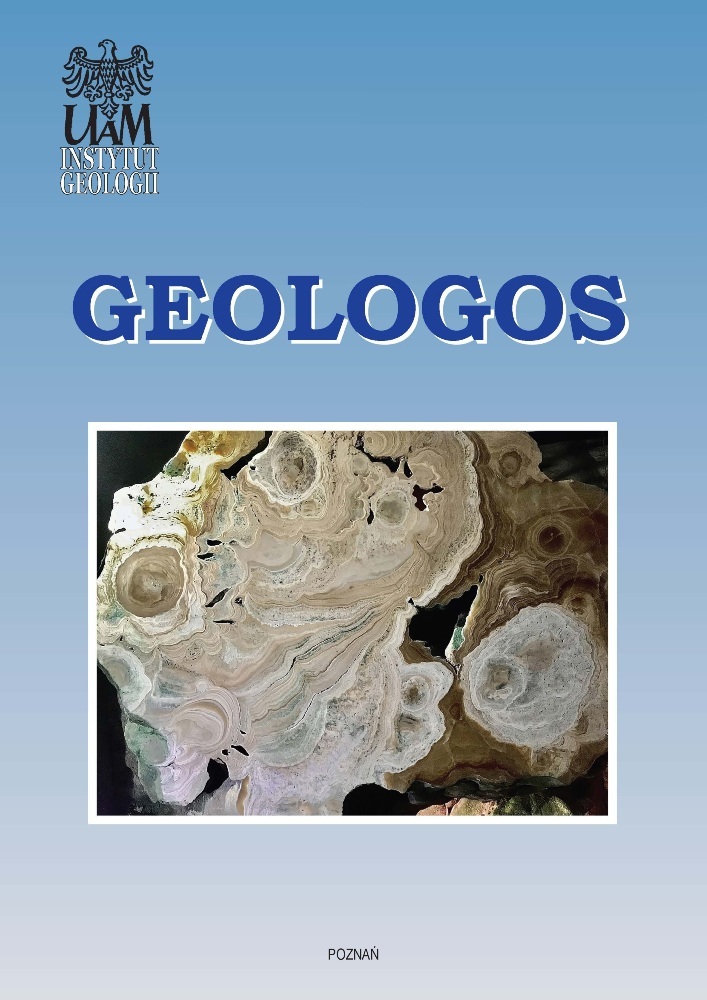Abstract
A specimen of the Sahara 02500 ordinary chondrite contains shock-produced veins consisting of recrystallised fine-grained pyroxenes that include small droplets of Ni-rich metal. Non-melted olivines and pyroxenes show planar deformations filled by shock-melted and -polluted metal and troilite. Shock-melted feldspathic glass is present close to the shock veins. Geothermometric estimations indicate that the meteorite locally experienced moderate shock metamorphism with a minimum local peak temperature above 1400°C, resulting in partial melting of Ca-poor pyroxene and full melting of feldspars, metal and sulphides. The mineral assemblage in the shock veins suggests a pressure during melt recrystallisation below 10 GPa.
References
Agee, C. B., Li, J., Shannon, M. C. & Circone, S., 1995. Pressure-temperature phase diagram for the Allende meteorite. Journal of Geophysical Research 100, 725-740.
Bogert, C. H., Schultz, P. H. & Spray, J. G., 2003. Impact-induced frictional melting in ordinary chondrites: a mechanism for deformation, darkening, and vein formation. Meteoritics & Planetary Science 38, 15211531.
Brearley, A. J. & Jones, R. H., 1998. Chondritic meteorites. [In:] J. J. Papike (Ed.): Planetary materials. Reviews in Mineralogy 36, 4-90.
Chen, M., El Goresy, A. & Gillet, P., 2004. Ringwoodite lamellae in olivine: clues to olivine-ringwoodite phase transition mechanisms in shocked meteorites and subducting slabs. Proceedings of the National Academy of Sciences of the USA 101, 15033-15037.
Lindley, D. H., 1983. Pyroxene thermometry. American Mineralogist 68, 477-493.
McDuff, R.E & Ross, E., 2001. Heath phase diagrams and petrological relationships in generation of the ocean crust. https://www.ocean.washington.edu/oc540/lec01-6/
Ohtani, E., Kimura, Y., Kimura, M., Takata, T. & Konodo, T., 2004. Formation of high-pressure minerals in shocked L6 chondrite Yamato 791384: constraints on shock conditions and parent body size. Earth and Planetary Science Letters 227, 505-515.
Putirka, K. D., 2005. Mantle potential temperatures at Hawaii, Iceland and mid-ocean ridges systems, as inferred from olivine phenocrysts: evidence for thermally driven mantle plumes. Geochemistry, Geophysics, Geosystems 6.5, 1-14 (doi: https://www.doi.org/10.1029/2005GC000915).
Rubin, A. E., 1992. A shock-metamorphic model for silicate darkening and compositionally variable plagioclase in CK and ordinary chondrites. Geochimica et Cosmochimica Acta 56 17051714.
Rubin, A. E., 2002. Smyer H-chondrite impact-melt breccia and evidence for sulfur vaporization. Geochimica et Cosmochimica Acta 66, 699-711.
Stoffler, D., Keil, K. & Scott, E. R. D., 1991. Shock metamorphism of ordinary chondrites. Geochimica et Cosmochimica Acta 55, 3845-3867.
Van Schmus, W. R. & Wood, J. A., 1967. A chemical-petrologic classification for the chondritic meteorites. Geochimica et Cosmochimica Acta 31, 747-765.
Xie, Z., Sharp, T. G. & De Carli, P. S., 2006a. High-pressure phases in a shock-induced melt vein of the Tenham L6 chondrite: constraints on shock pressure and duration. Geochimica et Cosmochimica Acta 70, 504-515.
Xie, Z., Sharp, T. G. & De Carli, P. S., 2006b. Estimating shock pressures based on high-pressure minerals in shock-induced melt veins of L chondrites. Meteoritics & Planetary Science 41, 1883-1898.
Xie, X., Sun, Z. & Chen, M., 2011. The distinct morphological and petrological features of shock melt veins in the Suizhou L6 chondrite Meteoritics & Planetary Science 46, 459-469.
Yang, C. W., Williams, D. B. & Goldstein, J. I., 1997. A new empirical cooling rate indicator for meteorites based on the size of the cloudy zone of metallic phases. Meteoritics and Planetary Science 32, 423-9.
License
This content is open access.
